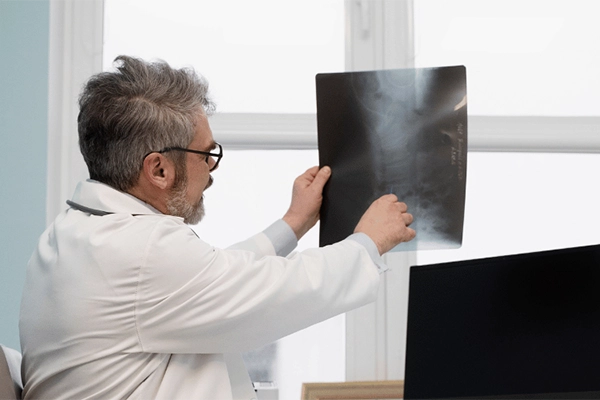Topics
What is joint hyperextension injury?
Joint hyperextension injury occurs when a joint is forced beyond its normal range of motion in the opposite direction of its normal flexion. This can cause damage to the ligaments, tendons, and other soft tissues surrounding the joint, as well as the joint itself.
What are the common joint hyperextension injuries?
- Hyperextension of the knee joint: A hyperextended knee occurs when your knee is bent backwards beyond its normal range of motion. Common injuries include anterior cruciate ligament (ACL), posterior cruciate ligament (PCL), and meniscal tears.
- Hyperextension of the ankle joint: This injury occurs when the ankle joint is extended beyond its normal range of motion. It is commonly seen in sports that involve jumping or sudden changes in direction, such as basketball or soccer.
- Hyperextension of the shoulder joint: This injury occurs when the shoulder joint is hyperextended. It is commonly seen in sports that involve overhead movements, such as volleyball or swimming.
- Hyperextension of the elbow joint: This injury occurs when the elbow joint is extended beyond the normal range of motion due to sudden forceful trauma or from repetitive stress of the joint.
- Hyperextension of the fingers: This injury occurs when the fingers are bent backwards beyond the normal range of motion. Common finger hyperextension injuries include sprains and dislocations.
What are the risk factors for joint hyperextension injuries?
Risk factors for joint hyperextension injuries include:
- Age: Our joints may become less flexible and more susceptible to hyperextension injuries as we age.
- Poor technique: Improper technique during participation in high-impact activities such as running, gymnastics, racquet sports and martial arts may cause excessive strain on the joints and increase the risk of hyperextension injuries.
- Weak muscles: Weak muscles around the joints may increase the risk of hyperextension injuries because of inadequate support and stability.
- Previous injury: This may weaken the ligaments and tissues around the joint, making them more susceptible to hyperextension injuries.
- Joint laxity: Individuals with naturally loose or unstable joints may be more susceptible to joint hyperextension injuries.
What are the symptoms of joint hyperextension injuries?
The symptoms of joint hyperextension injuries depend on the severity of the injury, but common symptoms include:
- Pain
- Joint swelling
- Bruising
- Stiffness
- Muscle spasm
- Joint instability
How is a hyperextended joint injury diagnosed?
Your doctor would first question your general health and symptoms before conducting a thorough physical examination. Diagnosis is made based on your reported symptoms, physical examination, and investigations.
Imaging tests such as X-rays, computed tomography (CT) scans, or magnetic resonance imaging (MRI) may be used to confirm the diagnosis and evaluate the severity of the injury. These tests can help identify any fractures, dislocations, or other structural damage that may have occurred due to the injury.
How is a hyperextended joint injury treated?
Treatment for a hyperextended joint injury depends on the severity of the injury, the joint involved, and other factors such as age, overall health, and activity level.
In general, treatment for a hyperextended joint injury may include the following:
-
PRICE - Protection, Rest, Ice, Compression, Elevation
PRICE is a common approach for the first two or three days.
- Protection: The use of protective support such as an elastic bandage, splint, or cast, depending on the extent of the injury.
- Rest: Limit weight bearing and avoid activities that may aggravate the injury.
- Ice: Apply ice packs to the affected area for at least 15 to 20 minutes, several times a day, until swelling improves.
- Compression: To reduce swelling and support the joint by wrapping the affected joint with an elastic bandage.
- Elevation: Keep the affected joint above the level of the heart to reduce swelling.
- Medication: Pain and swelling can be managed with oral or topical nonsteroidal anti-inflammatory drugs (NSAIDs) such as ibuprofen.
- Physiotherapy: Range of motion exercises only after the acute pain and swelling have subsided.
When should I visit a doctor?
If the injured joint remains swollen or painful for several days despite the measures above, you need to be evaluated by an orthopaedic specialist to ensure there is no fracture and to determine the suitable treatment option.
What can I do to prevent joint hyperextension injuries?
Here are some tips to prevent joint hyperextension injuries:
- Ensure adequate stretching and warming up before engaging in physical activities.
- Use proper techniques when participating in high-impact activities.
- Overuse of the joints can increase the risk of hyperextension injuries. Make sure to give your joints adequate rest and recovery time between workouts and activities.
- At home, always use the right tools or equipment to reach things. Refrain from standing on countertops, chairs, or tables.
- Wearing supportive shoes can help provide additional support for the joints and reduce the risk of hyperextension injuries.
Make an appointment at Pantai Hospitals
Speak to your doctor to know more about joint hyperextension injuries. A dedicated and expert team of Orthopaedic specialists at Pantai Hospital is available for consultation to provide the best care and assistance.
If you or someone you know is experiencing a medical emergency or major trauma, head straight to the Accident and Emergency (A&E) department at your nearest Pantai Hospital for immediate medical attention. The team of skilled emergency physicians, nurses, and support staff is available 24/7 to provide immediate care and support.
Pantai Hospital has been accredited by the Malaysian Society for Quality in Health (MSQH) for its commitment to patient safety and service quality.
References
- What is a hyperextended knee? Available at https://www.medicalnewstoday.com/articles/320454 [Accessed on 9 February 2023]
- What is a finger hyperextension injury? Available at https://www.physio.co.uk/what-we-treat/musculoskeletal/conditions/hand/hyperextension-injury.php [Accessed on 9 February 2023]













